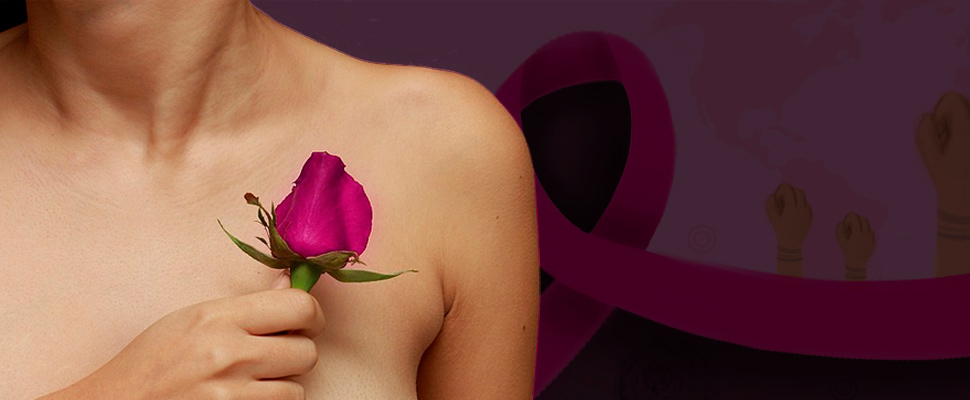International day against breast cancer
Know what this disease is about, what the symptoms are and how to prevent it

Woman holding a rose against her chest. / Photo: LatinAmerican Post
LatinAmerican Post | Marcela Peñaloza
Listen to this article
Leer en español: Día mundial de la lucha contra el cáncer de mama
Today October 19 marks the World Day of the fight against breast cancer to raise awareness in society about this disease that annually produces 458,000 deaths. WHO emphasizes that this type of cancer is "by far the most frequent in women, both in developed and developing countries." This is why knowing what breast cancer is, what the symptoms are and how it can be prevented.
In LatinAmerican Post we tell you what you should know about this disease, which not only affects women, but can also develop in men.
What is and where does breast cancer occur?
Breast cancer or breast cancer occurs when breast cells begin to grow out of control in this area of the body. According to the American Cancer Society, “breast cancer cells usually form a tumor that can often be seen on an x-ray or can be felt as a lump or lump. Breast cancer occurs almost exclusively in women, but men can also get it. ”
However, not all the masses that occur in the breasts are malignant. It can be non-cancerous tumors that do not pose a danger to the person's health. The important thing is that, before the detection of any abnormality, a specialist is immediately consulted so that it can be determined what type of tumor it is and the treatment to be followed.
This type of cancer can occur in four parts of the breast. The American Cancer Society explains that malignant tumors can form in these places:
- Most breast cancers begin in the ducts that carry the milk to the nipple (ductal cancers).
- Some cancers originate in the glands that produce milk (lobular cancers).
- There are also other types of breast cancer that are less common such as the phyllodes tumor and angiosarcoma.
- A small number of cancers begins in other breast tissues. These cancers are called sarcomas and lymphomas, and they are not really considered breast cancers.
Read also: New treatment improves survival in women newly diagnosed with advanced ovarian cancer
What are breast cancer symptoms?
Breast cancer can manifest itself in different ways. Mayo Clinic reports that the symptoms you should be aware of are:
- A lump or thickening in the breast that feels different from the surrounding tissue.
- Change in size, shape or appearance of a breast.
- Changes in the skin that is on the breast, as dimple formation.
- The recent inversion of the nipple
- Flaking, skin shedding, scabbing and peeling of the pigmented area of the skin surrounding the nipple (areola) or breast skin
- Redness or small holes in the skin that is on your breast, like the skin of an orange.
It is essential that you go to a doctor if you detect any of these symptoms or any alteration in your breasts. Early detection is essential in treatment.
How to prevent breast cancer?
Awareness and awareness about this disease play an important role in the early detection of the disease. That is why knowing about the disease and sharing that information with your family and friends circle can help reduce the number of deaths due to breast cancer. Remember to always consult specialized portals and do not spread false news. A specialist will always be the best option to solve your doubts.
However, there are risk factors that increase the chance of developing breast cancer. Among them is:
- Smoke
- To drink alcohol
- Obesity
- Early menstruation
- Not breastfeeding
- Genetic background
- Hormone therapy
To reduce the chances of suffering from this disease, WHO recommends:
- No Smoking
- Control your weight
- Limit or avoid alcohol consumption
- If you have children, breastfeed them
- Lead a physically active life
- Avoid being exposed to radiation
Touch yourself! Self-examination can save your life
Once a month you must perform the self-examination to detect any anomaly. How to do it? Medlineplus Explain that you should do it like this:
- Place the right hand behind the head. With the middle fingers of the left hand press gently but firmly making small movements to examine the entire right breast.
- Then, while sitting or standing, palpate the armpit, as the breast tissue extends to this area.
- Gently press the nipples, checking for secretion. Repeat the process in the left breast.
You may be interested: New drug overcomes resistance in aggressive breast cancers
In front of a mirror, open your arms and perform the following process:
- Look at the breasts directly in the mirror. Look for changes in skin texture, such as dimples, wrinkles, dents or skin that looks like orange peel.
- Also observe the shape and contour of each breast.
- Check to see if the nipple is sunk.




